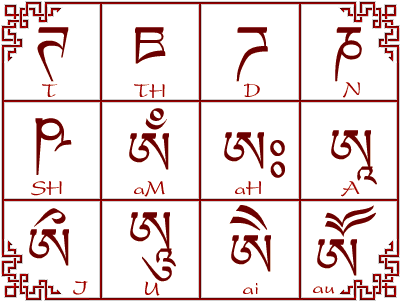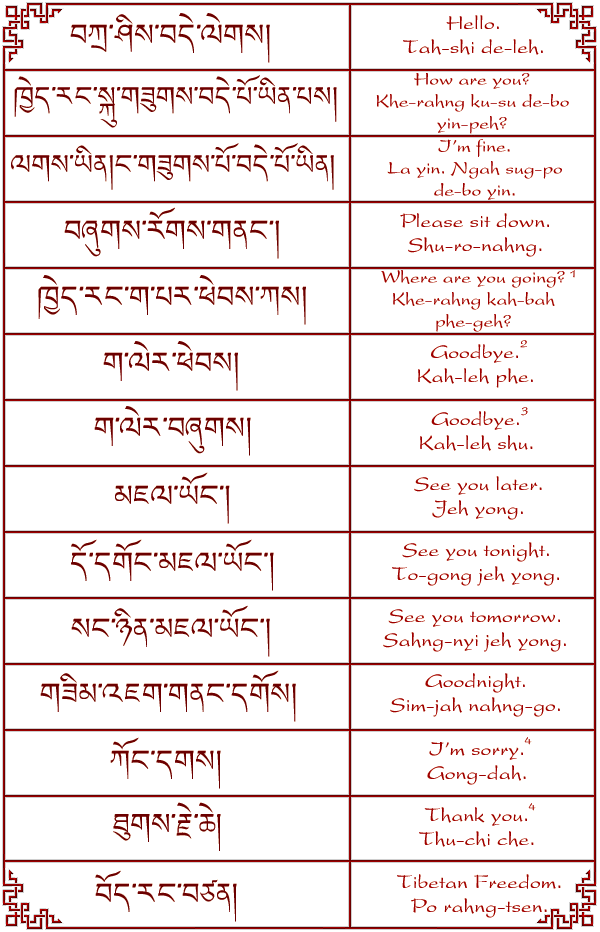
Happy Tibetan New Year
The Year 2131 - Year of the Iron-Serpent
February 23, 2004
So you want to learn Tibetan... Let's start with the alphabet. If you would just like a translation, please follow the instructions at the bottom of this page.
The Alphabet
Consonants
The Tibetan alphabet is derived from the ancient Brahmi script - so one can see similarities to the Indian alphabets. There are actually two different styles of the Tibetan script. The one presented here is dbu can (u-chen) or headed writing. This is most commonly found in print - that is in newspapers, books, etc. and electronic format. Here are the consonants called gsal byed (sal je). If you noticed, each Tibetan term I've already presented is written, and then something ap pears in parentheses. The letters are shown with the Wylie transcription - this is, just a representation of the Tibetan letters in the Roman (English) script - this shows EXACTLY how the Tibetan word is spelled in Tibetan writing. This system is derived from a certain Tibetan dialect - but does not reflect the most common pronounciation (Lhasa Tibetan). Such a difference appears between the two since many of the Tibetan letters can also be used to mark tone, change a vowel sound, or even change the sound of another consonant. So, I suggest learning the Wylie transcription scheme so you can write transcribed words in the native Tibetan. Then, learn the pronunciation that will be shown later so you can actually speak and read aloud the language. You may notice each letter is followed by a small dot - this represents the end of a syllable. Each letter has "a" inherently as its vowel, which can be changed by vowels given below this chart. Remember - these English equivalents are just for transcription - not pronounciation.
Click here if you would like to see the dbu med (u-me) or "headless writing" alphabet.
Vowels
Here are the vowels or dbyangs (yang). Each letter above has an inherent "a" pronounced like "but." In order to change this vowel to another sound (ie. if the vowel is not "a"), a mark is placed above or below the consonant. A vowel written alone uses either the Tibetan letter a or 'a - the difference in transcription symbol is only to represent a different letter form. I is pronounced like "fit." E is pronounced like "May." U is pronounced like "foo d."
The names of the vowels are - gi-gu, shup-ju, dreng-bu, and na-ro
Consonants Conjuncts
One will frequently find consonant stacks - that is letters on top of each other. Some letters take special forms when being stacked. Here are those special forms attached to the letter k for the sake of example.
Some characters always form these stacks even if they do not have a special form. Three are called rango, lango, and sango. These mean that the letters ra, la, and sa are superscribed (or on top of) another letter. The subscribed forms are wata, yata, rata, lata, and hata. Here are examples are all of these attached to "g" - combinations of more than one of these are also given. Remember, whenever you see these letter combinations with any other letter, a stack will appear:
1 - ga; 2 - gwa; 3 - gya; 4 - gra; 5 - gha; 6 - gla; 7 - rga; 8 - lga; 9 - sga; 10 - grwa; 11 - rgwa; 12 - rgya; 13 - sgya; 14 - sgra
These seem to be strange combinations of sounds... but remember, this does not necessarily relfect the pronounciation - for example, the stack gra is pronounced "Tha". If you see any examples such as these in transcribed Tibetan, the letters are written in a stack instead of next to eachother.
Sanskritic Letters
The Tibetan alphabet was created also with the idea for using it to write Sanskrit words. So, extended letters were created to account for the letters not found in the Tibetan alphabet. These are pretty easy to figure out - they are not really a part of the alphabet - you should be at least familiar with them although they appear infrequently. "T, TH, D, N, and SH" are retroflex consonants. "H" is a visarga and pronounced like a breathy "h". "M" is an anusvAra and represents nasalization. The others represent Sanskrit long vowels.
Numbers
Let's not forget the numbers. For the most part, they operate like our number system.
I suggest printing out the main consonants and vowels for a handy reference. Here are some pronunciation tips:















